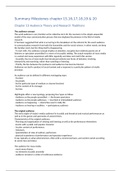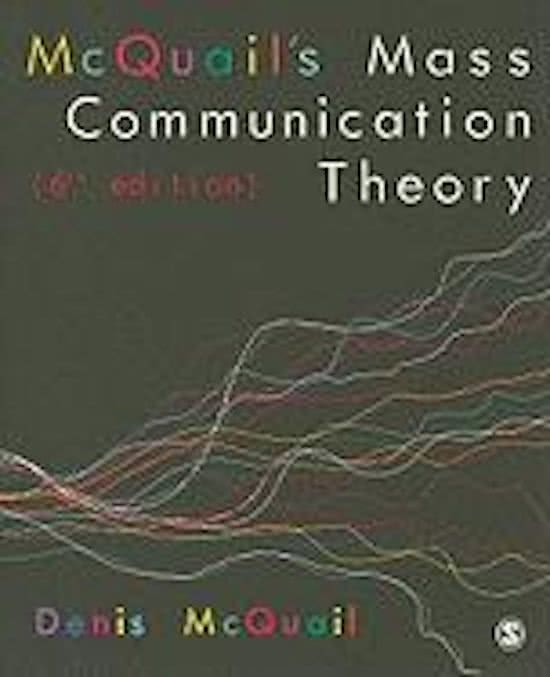Summary Milestones chapter 15,16,17,18,19 & 20
Chapter 15 Audience Theory and Research Traditions
The audience concept
The word audience is very familiar as the collective term for the receivers in the simple sequential
model of the mass communication process that was deployed by pioneers in the field of media
research.
It has been suggested that what is occurring is the breakdown of the referent for the word audience
in communication research from both the humanities and the social science. In other words, we keep
the familiar word, but the thing itself is disappearing.
- To start with, the audience concept implies an attentive, receptive but relatively passive set of
listeners or spectators assembled in a more or less public setting. The actual reception of mass media
is a varied and messy experience with little regularity and does not match this version.
- Secondly, the rise of new media has introduced entirely new forms of behavior, involving
interactivity and searching, rather than watching or listening.
- Thirdly, the line between the producers and audiences has become blurred.
Audiences are both a product of social context and a response to a particular pattern of media
provision.
An audience can be defined in different overlapping ways:
- by place
- by people
- by the particular type of medium or channel involved
- by the content of its message
- by time
Nightingale offers a new typology, proposing four types as follow:
- Audience as the people assembled. -> the known spectators
- Audience as the people addresses. -> inscribed or interpellated audience
- Audience as happening. -> interactive event in daily life
- Audience as hearing or audition. -> participatory audience
The original audience
The early origins of today’s media audience lie in public and theatrical and musical performances as
well as in the games and spectacles of ancient times.
Characteristics of the original audience:
- Planning and organization of viewing and listening as well as the performance themselves
- Events with a public and popular character
- Secular content of performance
- Voluntary
- Specialization of roles of authors, performers
- physical locatedenss of performance and spectator experience
It was typically an urban phenomenon, often with a commercial basis, and content varied according
to social class and status.
The audience for mass media
- much more diverse
- no elements of public assembly
- audience remains in a state of continuous existence
,- attracts a supply of content to keep it satisfied instead of reforming in response to some periodic
performance of interest.
From mass to market
The first theoretical formulation of the media audience concept stemmed from a wider consideration
of the changing nature of social life in modern society. The mass audience was large, heterogeneous
and widely dispersed and its members did not and could not know each other. When used by early
commentators, the term generally had a pejorative connotation, reflecting a negative view of popular
taste and mass culture.
Rediscovery of the audience as a group
While impersonality, anonymity and vastness of scale might describe the phenomenon in general,
much actual audience experience is personal, small-scale and integrated into social life and familiar
ways. The social interaction that develops around media use helps people to incorporate it into
everyday life as a friendly rather than an alienating presence.
Audience as market
As the media have become bigger business, the term market has gained in currency. It may be
defined as an aggregate of actual or potential consumers of media services and products, with a
known social economic profile. It is also problematic and not value-free. It privileges social-economic
criteria and focuses on media consumption rather than reception. Effective communication and the
quality of the audience experience are of secondary importance in market thinking. The view of
audience as market is inevitably the view from the media, and within the terms of the media
industries discourse.
Canadian Dallas Smyte; theory that audiences actually work for advertises. They do so by giving their
free time to watch media, with this labor then packaged and sold by the media to advertisers as a
new kind of commodity.
It is plausible to suppose that the media need their audience more than audience need their media,
and there is also reason to view audience research as primarily a tool for the close control and
management of media audiences.
Bermejo suggest that in the case of search engines, it is not the watching time of audiences that is
sold to advertisers, but words.
Ratings; are described as forming the basis for the agreed-upon standard by which advertisers and
networks buy and sell the audience commodity.
Ang argued that media institutions have no real interest in knowing their audience, only in being able
to prove they exist by way of systems and techniques of measurement which convince their clients,
but which can never being to capture the true essence of audience hood.
The audience as a market: main theoretical features
- Audiences are aggregates of many potential or actual consumers
- Members are unrelated to each other and have no shared identity
- Boundaries assigned to audiences are based mainly on socio-economic criteria
- Audiences are objects of management and control by media providers
- The formation is temporary
- Public significance is subordinate
- Relations of audience with media are mutually calculative, not moral
Goals of audience research
All research shares the general characteristic that it helps to construct, locate or identify an otherwise
amorphous, shifting or unknowable social entity.
,Varied goals of audience research
Media centered goals
- Measuring actual and potential reach for purposes of book-keeping and advertising
- Managing audience choice behavior
- Looking for new audience market opportunities
- Product testing and improving effectiveness form the perspective of the sender
Audience centered goals
- Meeting responsibilities to serve an audience
- Evaluating media performance from an audience perspective
- Charting audience motives for choice and use
- Uncovering audience interpretations of meaning
- Exploring the content of media use
- Assessing actual effects on audiences
Although it is not all sure that audience research can ever truly serve the audience alone, we can
provisionally view the different purposes of research as extending along a dimension ranging from
audience control to audience autonomy. By far the greatest quantity of audience research belongs at
the control end of the spectrum, since this is what the industry wants and pays for.
The clearest line of development in audience theory has been a move away from the perspective of
the media communicator and towards that of the receiver. Account of audience research have
increasingly tended to emphasize the rediscovery of people, in the sense of recognizing that the
initiative for choice, interpretation and response primarily lies much more with receivers than with
senders, and the notion of an active and obstinate audience in the face of attempted manipulation.
The preference of audiences are still the driving force of media use.
Alternative traditions of research
Structural, behavioral and social-cultural.
The structural tradition of audience measurement
The needs of media industries gave rise to the earliest and simplest kinds of research, which were
designed to obtain reliable estimates of what were otherwise unknown quantities. Size and reach of
radio audiences and reach of print publications. In addition to size, it was important to know about
the social composition of audience; who and where.
The behavioral tradition: media effects and media uses
Early mass communication research was mainly preoccupied with media effects, especially on
children and young people with an emphasis on potential harm. The typical effects model was a one-
way process in which the audience was conceived as an unwitting target of a passive recipient of
media stimuli. Media use was now central, and the audience was viewed as an active and motivated
set of media users, consumers, who were in charge of their media experience, rather than passive
victims. Research focused on the origin, nature of degree of motives for choice of media and media
content.
The cultural tradition and reception analysis
It emphasizes media use as a reflection of a social-cultural context and as a process of giving meaning
to cultural products and experiences in daily life. It involves a view of media use as in itself a
significant aspect of everyday life. Media reception research emphasized the deep study of audience’s
ad interpretative communities.
Audience ethnography:
1. It looks at a group of people rather than media or content
2. It follows the group in different locations
3. It stays long enough to avoid preconceptions.
, The main features:
- The media text must be read through the perceptions of its audience, which constructs meanings
and pleasures from the media texts offered
- The very process of media use and the way in which it unfolds in a context are central objects of
interest
- Media use is typically situation-specific and oriented to social tasks which evolve out of participation
in interpretative communities.
- Audiences for media genres often comprise separate interpretative communicates which share
much the same forms of discourse and frameworks for making sense of media
- Audiences are never passive, nor are all their member equal
- Methods must be qualitative and deep, often ethnographic, taking account of content, act of
reception and context together.
Structural Behavioral Cultural
Main aims Describe composition, Explain and predict choices, Understand meaning of
enumerate, relate so society reactions, effects content received and of use in
context
Main data Social-demographic, media Motives: acts of choice: Perceptions of meaning
and time use reactions regarding social and cultural
context
Main Survey and statistical analysis Survey; experiment; mental Ethnographic; qualitative
methods measurement
Audience issues of public concern
Main issues and problems that have shaped thinking and research about mass media audiences,
aside from the obvious practical need to have basic information about the audience.
Media use as addiction
Excessive media use has often been viewed as harmful and unhealthy, leading to addiction,
dissociation from reality, reduced social contacts, diversion from education and displacement or more
worthwhile activities.
The mass audience as social atomization
The more an audience is viewed as an aggregate of isolated individuals, the more it can be considered
as a mass with the associated negative features of irrationality, lack of normative self-control and
vulnerability to manipulation. The contemporary fragmentation of the audiences poses a new threat
of loss of national cohesion, following the decline of central broadcasting institutions.
Manipulation or resistance
Early formulations of the audience viewed it as readily available as an object of manipulation and
control, open to suggestions and foolish in its adulation of media celebrity. Research emphasized the
facts that audiences have social and cultural roots and supports that protects them against unwanted
influence and make for more autonomy in choice and response to what they receive.
Minority audience rights
An audience research projects that is independent on people-centered should pay attention to the
needs and interest of minorities by way of recognition and finding ways to promote their viability. In
this context, minority covers a potentially wide range of factors, including gender, political dissent,
locality, taste, age, ethnicity and much besides.






